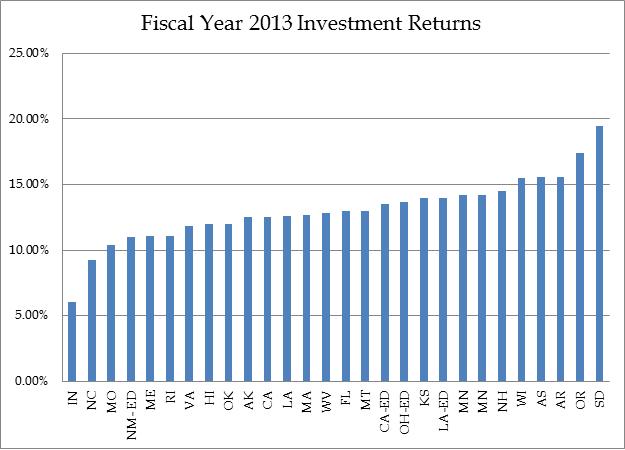Josh Elliott-Traficante
September 2013
The New Hampshire Retirement System announced that for fiscal year 2013, the state’s retirement fund saw a 14.5% return on its investments. Broken out by the different investment classes, domestic stocks saw a 23.2% return, foreign stocks 13.8%, bonds 2.8%, real estate 12.3% and alternatives assets[i] 8.7%.
While 14.5% return makes for a great year, being 6.75 percentage points above the assumed rate of return of 7.75%, that number alone does not really speak to how well the fund did in relative terms. For example, 14.5% looks quite paltry if other state pension systems uniformly saw 24.5%. Likewise, 14.5% looks like a fantastic return if the fund benchmarks saw only 6%.
How well did the New Hampshire Retirement System really do? There are two good comparisons to make that give a better sense of investment performance: the fund’s own benchmarks and the experience of other public sector pension funds. Measured against both internal benchmarks and the performance of other pension funds, New Hampshire did slightly better than average.
Benchmarks:
The New Hampshire Retirement System has a series of internal benchmarks, which are derived from stock indices blended with historical investment decisions. Each asset class has their own benchmark, which are then combined into a total fund benchmark.
Looking at the individual asset classes, nearly all of them met, or exceeded their respective benchmarks. Domestic stocks beat their benchmark by 170 basis points[ii], foreign stocks by 20 basis points, bonds by 240, real estate by 100, while 91 Day Treasury Bills hit their benchmark.
The one laggard was alternative investments, which fell 1240 basis points short of its benchmark. Over the long term, alternative investments have consistently fallen short of their benchmarks. In the last 10 years, this investment class has seen an average yearly return of 0.6%, while the benchmark has seen 9.1% on average.
For the year, the fund as a whole beat its benchmark by 100 basis points.
Other States:
Another useful measure is to look at the returns of other public sector pension funds. While each fund has its own investment strategy, risk tolerance, and portfolios, they are all operating in the same markets.
Among a sample of 28 public sector pension systems from 26 states that have released investment return data, New Hampshire’s returns are above average. For the returns sampled, the average return was 13.05%, with New Hampshire’s returns being 145 basis points higher.
What Good Returns Do Not Mean:
While there is little to criticize about a 14.5% return, the fact that the New Hampshire
Retirement System did well on the asset side this year does not mean all of the problems of the pension system are solved, just as last year’s returns of .9% did not mean that the System was in trouble.[iii]
Assets only account for one half of the ledger and to cite one year’s returns as a sign of the System’s financial strength (or weakness for that matter) is short sighted at best. It would be akin to highlighting the fact you got a $2000 raise, while not mentioning you took on more credit card debt at the same time. If you added 2500 in credit card debt in the same time, you are actually worse off. For a pension system, liabilities is that credit card debt. It remains to be seen is how much liabilities went up in 2013. If they increased more than assets did, then the system’s funding ratio goes down. If they increased less than assets did, then the ratio goes up.
While looking at asset growth and liability growth separately is valuable, to assess the health of the System, both asset and liability growth must be looked at together.

